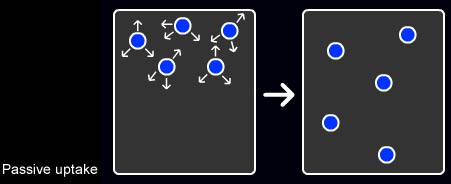Biosphere Contents
1. Organic Matter
Nutrient uptake in plants occurs by two mechanisms, passive or active
Passive uptake is a physical process that results from the random movement of molecules (diffusion) in the system. This causes the distribution of the molecules to become equalised.

If a plant root is growing in a soil solution that contains a higher concentration of an ion than the root itself does, there will be a tendency for that ion to diffuse into the root (if it can get in). However, it is frequently the case that plant roots contain higher concentrations of ion than the soil solute. These cannot have entered by diffusion alone, but must have been 'pumped' into the root by an active process (i.e. a process that requires energy).
Active uptake of ions from soil solution (or from fresh/sea water into plants) is brought about by carriers - proteins with similar properties to enzymes - that move the ions across the plasmalemma and into plant cells. This process requires energy. A good example of active uptake is seen in the cells of algae or higher plants where the concentrations of potassium and chloride ions are 1000 times higher than their concentrations in the outside medium.
How do plants take up nutrient elements?